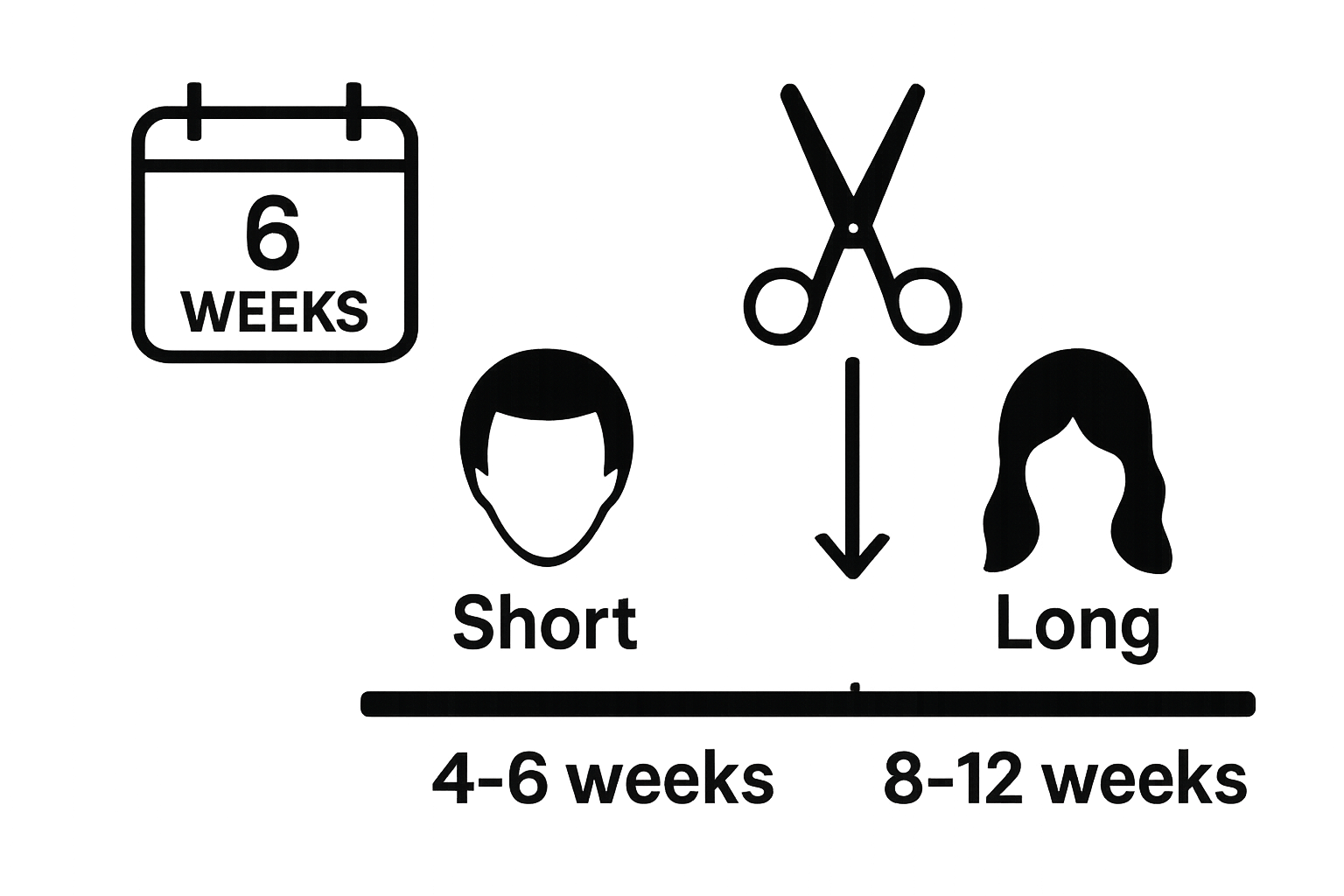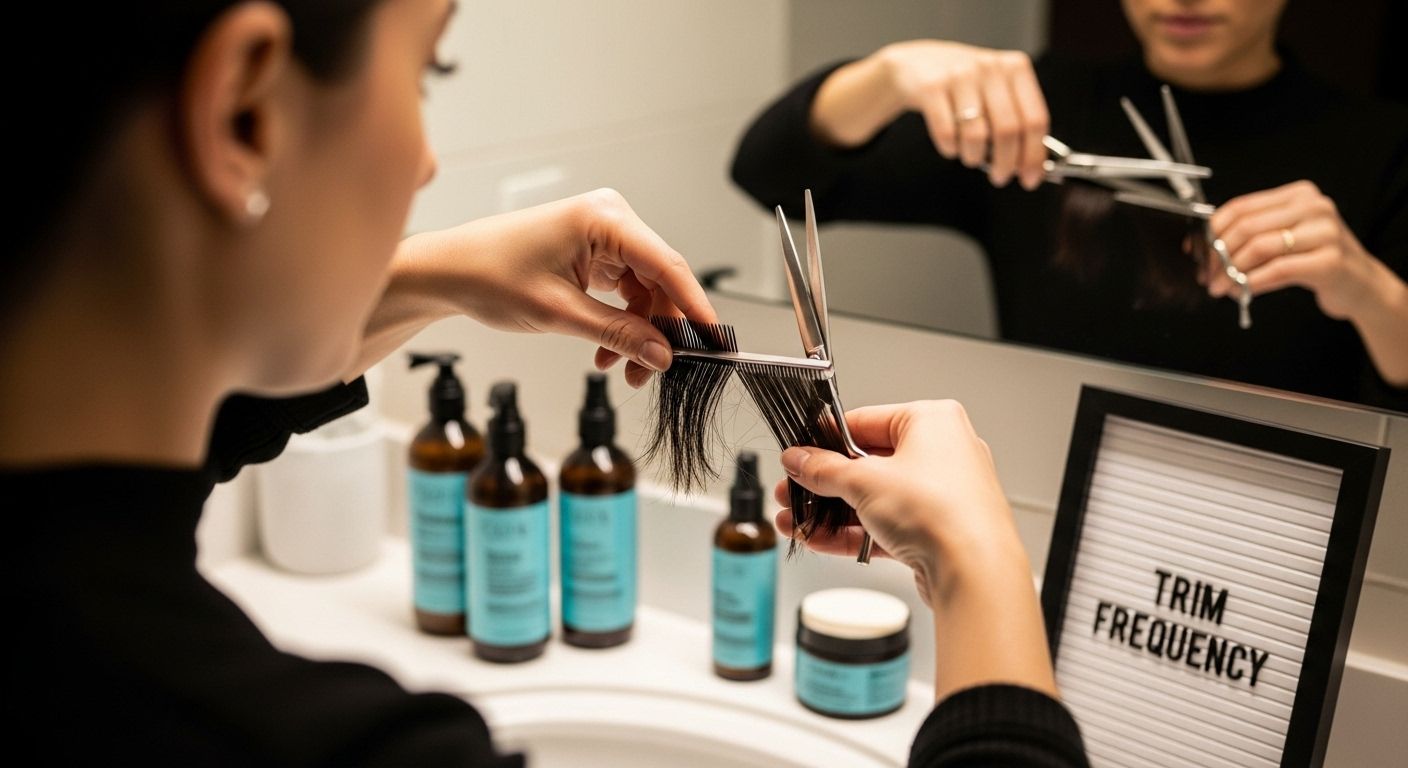Figuring out how often to trim your hair seems simple, but it is anything but routine. Some stylists say most people need trims every 6 to 8 weeks, yet that advice does not fit everyone. Most surprising? Your ideal trim schedule comes down to things like genetic hair type, daily habits, and even the season—not just how long your hair is or what style you want. The real secret to healthy, stylish hair is not in a one size fits all timeline, but in tuning your trims to your hair’s own natural rhythm.
Table of Contents
- Step 1: Determine Your Hair Type And Goals
- Step 2: Explore Recommended Trim Frequencies
- Step 3: Align Your Trim Schedule With Hair Growth
- Step 4: Create A Hair Care Routine To Support Growth
- Step 5: Schedule Regular Appointments With A Stylist
Quick Summary
| Key Point | Explanation |
|---|---|
| 1. Identify Your Hair Characteristics | Assess your hair’s texture, density, and curl pattern to determine trimming frequency and maintenance needs. |
| 2. Establish Trim Frequency Based on Hair Type | Fine hair requires more frequent trims than coarser textures to maintain health and style. |
| 3. Align Your Trim Schedule With Growth Cycles | Monitor split ends and hair behavior to time trims with natural growth phases effectively. |
| 4. Create a Comprehensive Hair Care Routine | Focus on nutrition, hydration, and a gentle care routine to promote healthier hair growth and management. |
| 5. Schedule Regular Appointments With a Stylist | Regular professional consultations help maintain hair shape, texture, and overall health through tailored strategies. |
Step 1: Determine Your Hair Type and Goals
Understanding your unique hair characteristics is the foundational step toward achieving a stylish and personalized hair trimming strategy. Before scheduling your next salon appointment, you need to conduct a comprehensive self assessment that goes beyond surface level observations.
Your hair type is determined by multiple critical factors including texture, density, curl pattern, and overall health. Start by examining your hair in its natural state without styling products. Pull a single strand and observe its thickness and shape. Fine hair appears almost translucent and feels delicate, while thick hair appears robust and maintains its shape easily. Curl patterns range from straight to tightly coiled, with multiple variations in between.
Identifying Your Specific Hair Characteristics
To accurately determine your hair type, you’ll want to perform a detailed evaluation. Assess your hair’s unique properties by considering these key aspects: strand thickness, scalp condition, natural oil production, and elasticity. Fine hair typically requires more frequent trims to maintain volume and prevent breakage, while coarser hair textures can tolerate longer intervals between cuts. Your personal styling goals play an equally significant role in determining trimming frequency.
Pay close attention to how your hair responds to styling, humidity, and current maintenance routine. Professional stylists recommend conducting a strand test to understand your hair’s true nature. Gently stretch a clean, dry hair strand and observe how quickly it returns to its original position. High elasticity indicates healthy hair that can withstand more styling manipulation, while low elasticity suggests you’ll need gentler, more strategic trimming approaches.
According to research from the National Institutes of Health, individual hair characteristics are primarily determined by genetic factors and can significantly influence your optimal hair care strategy. Understanding these nuanced details helps you make informed decisions about trimming frequency, styling techniques, and overall hair maintenance.
Successful hair type identification requires patience and careful observation. Document your findings through photographs, noting texture changes, growth patterns, and how your hair responds to different styling techniques. This personal hair journal becomes an invaluable resource for both you and your professional stylist, ensuring personalized care that meets your unique aesthetic and health requirements.
Step 2: Explore Recommended Trim Frequencies
Navigating the optimal trim frequency for your hair requires a nuanced understanding of multiple personal and styling factors. While general guidelines exist, your individual hair characteristics will ultimately determine the most appropriate maintenance schedule.
Hair length and texture play pivotal roles in determining ideal trim intervals. Shorter hairstyles typically demand more frequent maintenance to preserve their precise shape and structure. Professional stylists generally recommend trimming short hair every 4 to 6 weeks to maintain crisp lines and prevent uneven growth. Longer hair styles can typically extend trim intervals to 8 to 12 weeks, allowing for more flexibility in styling and growth management.

Personalized Trim Strategy Considerations
Your hair’s unique characteristics will significantly influence its ideal trim schedule. Fine, fragile hair requires more delicate and frequent maintenance compared to thick, robust hair textures. Those with chemically treated or frequently styled hair should anticipate more regular trims to counteract potential damage and maintain hair health. Color treated hair, in particular, benefits from strategic trimming to prevent breakage and preserve color vibrancy.
Consider your styling routine and personal aesthetic goals when establishing a trim frequency. If you prefer maintaining a precise, structured look, more frequent trims become essential. Individuals embracing a more relaxed, textured style might opt for slightly longer intervals between cuts. Professional stylists recommend paying close attention to your hair’s response to styling, noting signs of stress such as increased split ends, brittleness, or uneven texture.
According to research from the Mayo Clinic, regular trims are not just about aesthetic maintenance but also about preserving overall hair health. The process removes damaged ends, prevents potential breakage, and promotes healthier hair growth. By strategically timing your trims, you can effectively manage hair appearance while supporting its natural growth cycle.
Verify your personalized trim strategy by monitoring key indicators: consistent hair health, minimal split ends, maintained style integrity, and overall hair appearance.
To help you understand the differences in trim frequency recommendations based on hair type and style, the following table compares common guidelines mentioned in the article.
| Hair Type/Style | Recommended Trim Interval | Main Reason for Frequency |
|---|---|---|
| Short Hair | Every 4-6 weeks | Maintains precise shape and lines |
| Long Hair | Every 8-12 weeks | Allows flexibility, less upkeep |
| Fine Hair | Every 6-8 weeks | Prevents breakage and maintains volume |
| Coarse/Thick Hair | Every 10-12 weeks | More resilient, less prone to split ends |
| Chemically Treated Hair | Every 6-8 weeks | Counters damage, preserves health |
| Color Treated Hair | Every 6-8 weeks | Prevents breakage, preserves color vibrancy |
| Frequently Styled Hair | More frequent (6-8 weeks) | Mitigates heat and style damage |
 Remember that flexibility is key your ideal trim schedule may evolve with changes in hair texture, lifestyle, and personal styling preferences.
Remember that flexibility is key your ideal trim schedule may evolve with changes in hair texture, lifestyle, and personal styling preferences.
Step 3: Align Your Trim Schedule with Hair Growth
Understanding your hair’s natural growth cycle is crucial for developing a strategic trimming approach that supports both style and hair health. The human hair growth process occurs in three distinct phases: anagen (active growth), catagen (transition), and telogen (resting), each playing a significant role in determining the optimal timing for your haircuts.
Hair growth is not a linear process but a dynamic cycle influenced by multiple internal and external factors. Your individual genetic makeup, nutrition, stress levels, and overall health contribute to the unique rhythm of your hair’s growth pattern. Most people experience an average hair growth rate of approximately half an inch per month, though this can vary significantly based on personal characteristics.
Strategic Trimming for Optimal Hair Health
To effectively align your trim schedule with natural hair growth, you’ll want to observe your hair’s specific behavioral patterns. Pay attention to how quickly your hair develops split ends, experiences breakage, or loses its desired shape. These indicators will help you fine tune your trimming intervals. For individuals with high styling maintenance or chemically treated hair, more frequent trims become essential to prevent structural damage and maintain a polished appearance.
Consider the seasonal variations that might impact your hair’s growth and health. During winter months, hair tends to become more brittle and prone to breakage, suggesting that protective styling and slightly more conservative trimming might be beneficial. Conversely, summer months might allow for more aggressive styling and maintenance approaches. Your trim schedule should remain flexible, adapting to these natural fluctuations in hair growth and environmental conditions.
According to research from the British Journal of Dermatology, hair growth patterns can demonstrate seasonal variations, with peak growth periods and increased shedding phases. This scientific insight underscores the importance of a dynamic, personalized approach to hair maintenance.
To verify the effectiveness of your trim strategy, monitor key indicators such as hair strength, minimal breakage, consistent hair shape, and overall hair vitality. A successful trim schedule will leave your hair looking vibrant, feeling healthy, and maintaining its desired style with minimal effort.
Remember that your hair is a living, dynamic part of your body, and its care requires ongoing attention and adaptive strategies.
Step 4: Create a Hair Care Routine to Support Growth
Developing a comprehensive hair care routine goes far beyond occasional styling and periodic trims. Your daily approach to hair maintenance determines the overall health, strength, and appearance of your hair, directly influencing its growth potential and stylish presentation.
Nutrition and hydration form the fundamental cornerstone of exceptional hair health. What you consume plays a critical role in hair growth, with protein, vitamins, and minerals serving as essential building blocks for strong, resilient hair. Focus on incorporating lean proteins, omega-3 fatty acids, and iron-rich foods into your diet. These nutrients support keratin production and strengthen hair follicles from within, creating a robust foundation for healthy hair growth.
Holistic Hair Maintenance Strategies
Your daily hair care routine should be tailored to your specific hair type and personal styling goals. Begin by selecting gentle, sulfate-free shampoos and conditioners that match your hair’s unique characteristics. Avoid excessive heat styling and protect your hair from environmental stressors like direct sunlight, harsh winds, and extreme temperatures. Invest in quality microfiber towels or soft cotton t-shirts for drying, which minimize friction and prevent unnecessary hair damage.
Establish a consistent scalp care regimen that promotes healthy hair growth. Gentle scalp massages stimulate blood circulation, encouraging nutrient delivery to hair follicles. Use lukewarm water when washing your hair, as extremely hot temperatures can strip natural oils and cause unnecessary stress to your hair shaft. Consider incorporating weekly deep conditioning treatments that provide intense moisture and repair damaged cuticles. These treatments help maintain hair elasticity and prevent breakage, supporting your overall hair growth objectives.
According to research published in the National Institutes of Health, regular maintenance and protective strategies significantly contribute to hair strength and growth potential. Professional stylists recommend viewing hair care as a holistic process that extends beyond superficial styling.
Verify the effectiveness of your hair care routine by monitoring key indicators: reduced breakage, improved hair texture, consistent moisture levels, and enhanced overall hair appearance. A successful routine will leave your hair looking vibrant, feeling soft, and maintaining its stylish structure with minimal intervention. Remember that consistency is key your hair responds best to steady, thoughtful care that respects its natural characteristics and growth patterns.
Step 5: Schedule Regular Appointments with a Stylist
Scheduling professional hair appointments is more than a mere maintenance task it represents a strategic investment in your personal style and hair health. A skilled stylist transforms routine trims into precision artistry, ensuring your hair maintains its optimal shape, texture, and aesthetic appeal.
Professional stylists bring expertise that extends far beyond simple cutting techniques. They possess an intricate understanding of hair architecture, growth patterns, and styling potential that goes beyond what most individuals can achieve independently. When selecting a stylist, prioritize professionals who demonstrate technical skill, attentive listening, and a comprehensive approach to hair care.
Maximizing Your Stylist Consultation
Prepare for your appointment by documenting your hair goals, current challenges, and desired outcomes. Bring reference images that illustrate your vision, but remain open to professional recommendations. Explore our guide on essential hair consultation questions to ensure you communicate effectively with your stylist. A thorough consultation allows your stylist to create a personalized trimming strategy that aligns with your unique hair characteristics and lifestyle requirements.
Consider establishing a consistent appointment schedule that matches your hair’s specific growth and maintenance needs. For most individuals, this means booking trims every 6 to 8 weeks, though your exact interval may vary based on hair type, length, and styling frequency. Professional stylists recommend viewing these appointments as preventative maintenance, addressing potential issues before they become significant problems. During each session, discuss not just the immediate trim but also long term hair health strategies, potential style adjustments, and techniques for maintaining your desired look between appointments.
According to research from the American Academy of Dermatology, hair typically grows approximately half an inch per month, making regular professional assessments crucial for maintaining style and health.
Verify the success of your stylist relationship through tangible outcomes: consistent hair shape, reduced split ends, improved hair texture, and a style that feels authentically yours. A great stylist does more than cut hair they help you express your personal aesthetic while maintaining optimal hair health. Trust the process, communicate openly, and view each appointment as an opportunity to refine and elevate your personal style.
Here is a step overview table summarizing the five main steps for determining your ideal hair trim schedule, each with its focus and outcome.
| Step | Focus/Key Action | Expected Outcome |
|---|---|---|
| 1. Determine Hair Type & Goals | Assess hair texture, density, curl pattern | Informed about unique hair needs |
| 2. Explore Recommended Trim Frequencies | Review guidelines based on style and type | Personalized trim interval selected |
| 3. Align Trim Schedule with Growth | Monitor hair growth patterns and adjust trims | Trims timed to natural growth cycle |
| 4. Create Hair Care Routine | Implement nutrition, hydration, gentle care | Healthier, more resilient hair |
| 5. Schedule Stylist Appointments | Book regular trims & consult with a professional | Consistent professional maintenance and style |
Tired of Uncertain Hair Trims and Inconsistent Results?
If you find yourself struggling to decode the best trim frequency for healthier, more stylish hair, you are not alone. This article revealed how hard it can be to determine your unique hair type, align your trim schedule with real hair growth, and build a lasting hair care routine. Many people face the frustration of split ends, faded style, or hair that just will not cooperate. The guidance here is a great start, but sometimes you need true expertise to create a trimming plan that is as individual as your style goals.

Why wait for another disappointing haircut or ineffective routine? Discover what professional artistry feels like at Joel C Ma Hair Studio. Experience tailored consultations with our skilled team, led by a stylist with over 25 years of advanced techniques in personalized trims, color, and artful styling. Explore our service menu and premium offerings or book your own hair consultation today for results you can see and feel. Your best hair in 2025 starts now. Visit Joel C Ma Hair Studio and step into a new level of confidence.
Frequently Asked Questions
How often should I trim my hair for a stylish look in 2025?
Professional stylists generally recommend trimming short hairstyles every 4 to 6 weeks, while longer hairstyles can go for 8 to 12 weeks between trims. Your individual hair type and condition may affect this frequency.
What factors determine the best trimming frequency for my hair?
The ideal trimming frequency is influenced by hair length, texture, curl pattern, and styling routines. For example, fine hair may require more frequent trims to maintain volume, while coarser hair can tolerate longer intervals.
How can I identify my hair type for trimming purposes?
To determine your hair type, assess factors such as strand thickness, density, curl pattern, and overall health. Conducting a strand test can also provide insights into your hair’s elasticity and resilience, helping you decide trimming frequency.
What should I consider in my hair care routine to support healthy growth?
Develop a comprehensive hair care routine that includes proper nutrition, gentle cleansing with sulfate-free products, protective styling, and regular scalp massages. These measures support your hair’s growth and health, complementing your trimming schedule.





